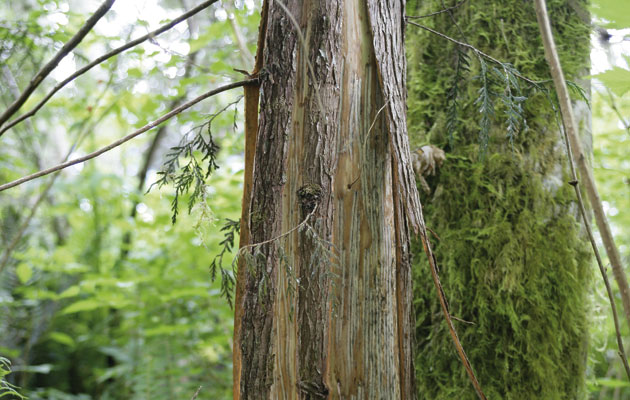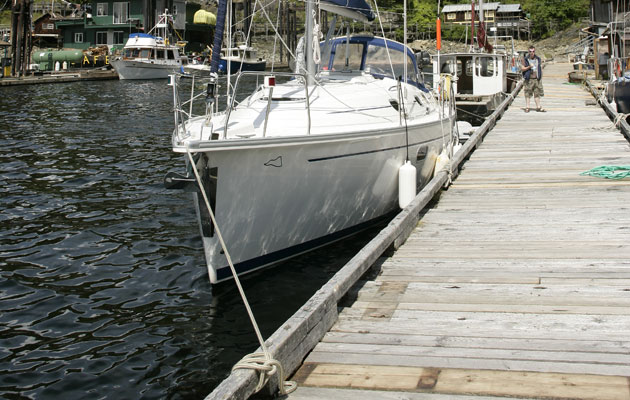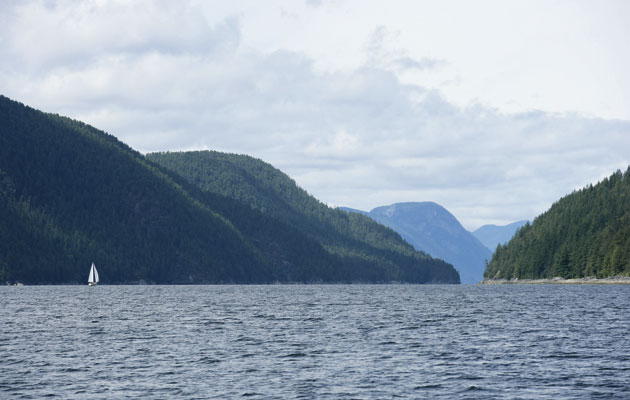Avoid the high season and a sailing charter in Desolation Sound can give you a genuine flavour of wilderness cruising. Chris Beeson explores Big Country
Charter in Desolation Sound
‘As the sun set in Desolation sound, the howling of wolves split the air in Carrington Bay. Moments later the epic silence returned broken only by the snap of burning logs.’
It was our last night in Desolation Sound, British Columbia, on Canada’s Pacific coast. We anchored in Carrington Bay on the north of Cortes Island, which, like the whole of Desolation Sound in early June it seemed, we had all to ourselves.

True wilderness cruising: on our last night in the Sound we cooked out in Carrington Bay, an entrancing anchorage with a tidal lake at its head
With a bucket of Pacific oysters we’d kicked from the rocks at low tide and the last of our victuals, we rowed to the island in the middle of the bay – the outboard’s clatter would have shattered the silence – built a fire and ate silently, using every sense to take in the solitude and grandeur of this remarkable place. By this time tomorrow we would be in Vancouver Airport where, in the blink of an eye, we would see ten times more people than we had in the previous ten days.

We twice sailed past an unflappable bald eagle, heard the chilling chorus of wolves and saw trees stripped of their bark by bears marking their territory. In Powell River Living magazine, George Campbell gave the following advice about bears: ‘Hikers in grizzly country are advised to carry a whistle, bell or air horn to keep these dangerous critters at bay. You should also be able to recognise any bear droppings you come across. Black bear droppings are full of huckleberry, blackberry and salmonberry seeds, whereas the droppings of the grizzly are full of whistles, bells and air horns’
Reading about Desolation Sound in Jonathan Raban’s acclaimed novel Passage to Juneau inspired me to charter Shadowfax V, a Gib’Sea 37, from Cooper Boating’s base in Powell River, 100 miles north-west of Vancouver. My crew were YM photographer Graham Snook and a friend, Ric Dudley, who is a member of London Corinthian Sailing Club. We chose 2-11 June, which is right at the start of the season, because we wanted Desolation Sound to look desolate. A month later and many of the anchorages we claimed as our own would be lined with hundreds of yachts moored stern-to.
After a short connecting flight from Vancouver airport to Powell River, we were met by Andrew from Cooper Boating’s Desolation Sound base. He showed us round town then took us to the Beach Gardens Resort hotel and marina. Shadowfax V waited alongside the raw wooden pontoons, which were bristling with splinters. No cleats anywhere, just iron rails, so you moor your yacht as you would tie up a horse. Andrew left us his pickup truck, so we could drive to the store for provisions, and said goodnight.

Graham whips up some pancakes for breakfast. Cruising in these waters is largely a self-catering affair
The following morning, after our briefing, we slipped past the seals and the huge bald eagle standing sentry on the breakwater, and headed north up the Strait of Georgia, through the Thulin Passage and past Sarah Point into Desolation Sound.

A bald eagle eyes us as we slip out of Cooper Boating’s Powell River base and head north for Desolation Sound
The scale of the sound is mind-numbing. It measures only 32 by 24km (20 by 15miles) but in the middle of Homfray Channel, less than 3.2km (2 miles) wide, we were in over 700m (2,300ft) of sounder-baffling, inky water with the cloud-wreathed peaks of the Unwin Range rising from the western side to a height of over 1.5km (5,000ft) within a mile of the shore. The frozen, shattered peak of Mount Denman, which caps the Unwin Range at 2km (6,590ft), looms overhead.

Prideaux Haven is the sound’s best known anchorage, at the south end of Homfray Channel, it encapsulates the scale and beauty of the area. We anchored in Melanie Cove and rowed the dinghy around to Laura Cove, which is similarly breathtaking
The stupendous topography prevents a good sailing breeze. We moored on the breathless plate glass of Melanie Cove, in Prideaux Haven, and during lunch – huge Pacific oysters again, this time wrapped in bacon – the owner of a nearby yacht, one of the handful we saw in ten days, kayaked across and asked us what the gale was like. Apparently, there was a Force 8 in Comox, 40km (25 miles) down the Strait of Georgia.

Sailing south-west down Sutil Channel with clear skies and a glorious northwesterly. The scenery is awe-inspiring but the sailing is a mixed bag
With such varied conditions, we had a motoring-to-sailing ratio of about 70:30. There were a few cracking half-hour gusts around assorted headlands and a couple of sun-blessed afternoon passages with a brisk Force 5 northwesterly and a clear sky, but this trip wasn’t primarily about sailing. Cruising here is like going back in time. Among these vertiginous, impenetrable forests and unfathomable depths there are wolves howling and bears prowling, seals lounging, salmon running and deer sipping at the water’s edge.

There’s a stunning anchorage at the head of Teakerne Arm, where Cassel Lake empties in a cascade onto the rocks just metres away. Take the dinghy to a landing stage and you can walk up to the lake for a swim
Anchored in Teakerne Arm, 15ft off the cliff with a line ashore to a wire cable laid for mooring by a logging company decades ago, we paddled the dinghy ashore to the foot of the waterfall from Cassel Lake and collected a bounty of molluscs – ‘when the tide’s out, the table’s laid’, as they say in these parts. I felt uneasy and realised I was half-expecting someone with a flourescent jacket, a walkie-talkie and safety boots to make me replace the mussels before wearily directing me to the public viewing facility with gift shop and handing me a tourist leaflet in fifteen different languages. It felt like we’d discovered this place – we nearly named it. This really is a different world.

Graham with two of the huge Pacific oysters that litter the shoreline here: ‘When the tide’s out, the table’s laid’ as they say here
Care needs to be taken however. Blooms of a particular kind of plankton, known as red tides, temporarily make oysters deadly and notices are placed in affected areas. Paralytic shellfish poisoning starts as a tingling on the lips before paralysing first them, then the rest of the body and, within 24 hours, the heart. Survival requires hospital treatment and there isn’t one here. You can test oysters by dabbing the flesh with your finger and placing it against your lips. If you feel tingling, don’t eat them.
When we’d tired of the tranquil extremity of the sound, we sought out one of its most fearsome features – the infamous Seymour Narrows. Captain George Vancouver, who first charted the sound in 1792 for the Royal Navy, called this place ‘one of the vilest stretches of water in the world’. Discovery Passage is pinched to just 800 yards at Seymour Narrows and the current there behaves very strangely.
Jonathan Raban writes: ‘Water wasn’t meant to travel at 16 knots. It turns into
a liquid chaos of violent overfalls… it seethes and boils.’ Seymour Narrows is a comparatively busy thoroughfare between Discovery Passage and the Strait of Georgia. It has claimed at least 119 vessels and 114 lives, mostly victims of Ripple Rock, a fateful finger of granite in the centre of the narrowest section that rose from 80m (260ft) to within 3m (9ft) of the surface. Fortunately for us, it was blown up 50 years ago in the biggest man-made explosion since the end of the Second World War. The depth is now 13m (43ft).

Seymour Narrows is an awesome, adrenalin-pumping spectacle. Tides rip through here at 16 knots and several other bottlenecks have tides in excess of 10 knots. Make sure you’re aware of HW times and read the pilot guide
We tackled Seymour Narrows gingerly, as recommended in pilot books – at the turn of the tide and not under sail. We waited in Menzies Bay for the current to slow, watching a quarter-mile-long freight tow, one of the many that snake through the sound, get very sideways before straightening in the narrows. With a mere knot of tide against, we set off up the deeper west side. Five minutes later we had vast, billowing mushrooms of water to port, and to starboard vortices and water shivering itself into white shoulders. We slithered through between them.
Before attempting the southward passage we waited for 10 minutes in Plumper Bay for the water to calm down. It didn’t. We shot south on the east side with 4 knots under us and 10 minutes later we rolled out the sails to head south towards the Strait of Georgia.
To celebrate we went to the Heriot Bay Inn for a berth alongside and the first food in a week that we hadn’t cooked ourselves. After dining on a typically vast scale, we relaxed for the evening, played pool and enjoyed the band.
There was an unmistakably frontier feel at the hotel, a genuine warmth generated by people who spend so much time away from civilisation that company is always welcome. So bold did we feel that we agreed to join the crew of the prawner Steer Clear for 12 hours’ fishing the following day. At 0600, when we were due aboard, this was revealed as a shockingly poor decision and instantly reversed.
Much as we enjoyed our run ashore, we wanted to experience the wide-open wilderness once more before getting Shadowfax V back to her base. We chose Carrington Bay. After cooking over a log fire on an island in the middle of the Bay, dining under glittering stars, we paddled silently back to the boat, dazzled by phosphorescence, then sat in the cockpit transfixed by immense silence and epic loneliness.
Desolation Sound factfile
Getting there
We had a nine-hour flight from Heathrow to Vancouver with Air Canada and then a 45-minute connecting flight to Powell River with Pacific Coastal Airlines. See www.BritishColumbia.travel for more details.
Charter yachts
We chartered a Gib’Sea 37 from Vancouver-based Cooper Boating (www.cooperboating.com). We boarded at their Desolation Sound base.
Climate
‘Maritime temperate’ is the official description of Desolation Sound’s climate. ‘Changeable’ would be a more fitting adjective, but it enjoys the mildest climate and warmest water in Canada. From June to September, the average daily temperature range is 22-25˚C and the water temperature often exceeds 20˚C.
We had a mixed bag of weather: one whole day of drizzle, several days of glorious sunshine and plenty of cumulus in-between. The topography makes weather forecasts unreliable, but they are available on weather channels at WX7 and 8. Listen for ‘Strait of Georgia, north of Nanaimo.’
Pilot guides and charts
We used chart folio 3312 and Sailing Directions for British Columbia Coast, South Portion, both published by Fisheries & Oceans Canada.

Charts of the area are accurate, though you may struggle to believe them given the scale of the place
Provisioning
There are supermarkets in Powell River, a bustling metropolis in these parts, and in the paper-making town of Westbay, further north. Once into the sound, there is a basic general store in Refuge Cove and a supermarket in Heriot Bay, but that’s it. Enormous Pacific oysters and mussels are abundant and the waters teem with prawn and salmon in spawning season.

With its clapboard, Wild West-style store and a café, Refuge Cove is a comparative cosmopolis. Aside from being the only store in the Sound (there’s a supermarket just outside, at Heriot Bay), Refuge Cove also has a seaplane link to Vancouver, which makes the place something of a terminal in high season

The Sliammon native Indians are still here, living in First Nation settlements. RN Capt George Vancouver charted the area in 1792 aboard the square-rigger Discovery, naming features after himself (Vancouver Island), his officers (Puget Sound) and ship (Discovery Passage). He was baffled by the capricious winds and unplumbable depths, the random violence of the tides and the relentlessly damp weather. He said Teakerne Arm, one of the loveliest spots, ‘afforded not a single prospect that was pleasing to the eye’ and immortalised his dark mood by naming the area Desolation Sound










